 |
||
|
||
| ||
TABLE OF CONTENTSI feel like crying out: Gainward is back! But many readers will respond that it has never been gone. I already narrated the dramatic history of this company in previous articles. So now I'll just remind you that it had found itself on the verge of bankruptcy because of a wrong policy (to put it mildly) of the previous management. It was saved by the merger with a large Chinese financial holding. By the way, Palit also belongs to it. That's why there were some rumours that it was Palit that had bought Gainward. But that's not quite true. In fact, cards for Palit and Gainward are manufactured on the same plant, even production lines are the same. It took great efforts of the new Gainward management as well as the only large marketing specialist in the company to uphold a separate manufacturing process for Gainward cards with its own set of components as well as quality control, as products of this brand are held in respect for their quality! So the company couldn't afford to lose the brand. As one of those who was the first to introduce Gainward cards on the Russian market back in 2001 (that was an accident: I bought Gainward GeForce3 to install in my computer, which had been delivered from the USA, then a review was published, which got a lot of feedback, etc), I was very glad that the brand was not lost and that efforts of the new management started to yield fruit. But it's too early to speak of final success: there are few employees, many of them work on sheer enthusiasm. But it's nice to see Gainward offer unique cards, which used to be very popular (until the company started to buy reference cards from NVIDIA and raising prices for its brand). Today we shall examine two new cards, which have no counterparts in products from NVIDIA partners. We enumerate the new cards with a fraction bar for one reason: they have absolutely the same design, even memory chips are the same. Only GPUs are different. If you have heard about the 7800 GT for the first time, you may read our reference material that contains all main points about this GPU and cards, based on this chip. Besides, the key characteristics will be published below. The GeForce 6800 GS is just the NV41/NV42, that is GeForce 6800 (PCI-E), with 12 pixel pipelines, but operating at increased frequencies (relative to the 6800). Considering that the 6800 GS card was based on the 7800 GT PCB (reference cards from NVIDIA were just like that), the decision to use a unified PCB in this case does not look wrong. You should also remember that the GLH suffix (Goes Like Hell) in Gainward products means significantly increased frequencies, even higher than in Golden Sample (GS).
Video card
It's crystal clear that the design is completely overhauled compared to the reference. First of all it was done to use 136-pin memory chips of higher capacity (instead of 144-pin BGA chips). It made it possible to arrange chips more compactly on the front side of the PCB only, which allowed to use a single cooler for the core and memory. The cards have TV-Out with a unique jack. You will need a special bundled adapter to output video to a TV-set via S-Video or RCA. It's also used to connect HDTV. You can read about the TV-Out in more detail here. The cards are also equipped with DVI and VGA jacks. Two analog monitors with d-Sub (VGA) interfaces can be connected via a special DVI-to-d-Sub adapter. Maximum resolutions and frequencies:
All previously reviewed GTX/GT cards allowed to change the three core frequencies at 27 MHz steps, frequency of the geometry unit was higher by 40 MHz. I already described it in detail before. In this case the situation with the 7800 GT is the same. Even though the core frequency is specified to 450 MHz, it's only used to set the geometry unit frequency - 490 MHz. The other two units operate at 459 MHz, that is they come down to one of the values from the row 432-459-486-513 MHz.
Bundle
Box.
Installation and DriversTestbed configuration:
VSync is disabled.

RivaTuner (written by A.Nikolaychuk) readings showed that the 7800 GT core temperature under load raised nearly to 80°C in a closed PC case with standard cooling (from Chieftech). That's OK, even very good that the GPU temperature keeps within the admissible limits with such increased frequencies. That's why even though the cooling system itself does not drive the hot air out of a PC case, the temperature conditions are optimal. 
The 6800 GS gets a tad hotter, as its operating frequencies were raised a tad higher than in the previous case. What concerns the noise, the cooler can be controlled by RivaTuner, so you shouldn't worry about it. Moreover, when the fan speed drops to 25% of the nominal value, the temperature rises by 1-2°C maximum, an inappreciable result. What concerns overclocking, we managed to raise memory frequencies to 1510-1520 MHz, core frequencies - 7800 GT - 486 MHz, 6800 GS - 510 MHz. By the way, in our review below I also tested the 7800 GT at nominal 400/1000 MHz frequencies to compare the results with its 256 MB counterpart and with memory overclocked to 1510 MHz to study memory bandwidth effect on such cards. Test results: performance comparisonWe used the following test applications:
Game tests that heavily load vertex shaders, mixed pixel shaders 1.1 and 2.0, active multitexturing.FarCry, Research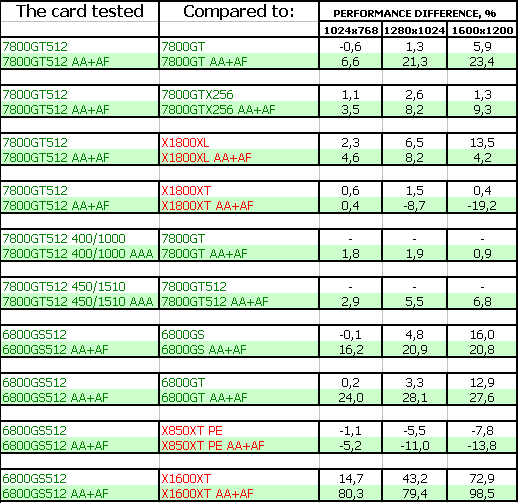
Considering that the game is limited by a CPU in case of powerful video cards operating without AA+AF, we shall analyze only tests with anti-aliasing and anisotropy: the new card based on 7800 GT shoots forward from the reference card by 21-23% - an impressive result! It even outperforms the 7800 GTX 256MB!!! Only the X1800 XT is a tad faster. Tests at the reference frequencies show that 512 MB of memory give no benefits to this card operating at the nominal frequencies. Increased memory bandwidth (from 1300 MHz to 1510 MHz) produces some effect. What concerns the 6800 GS, we can see up to 20% gain versus the reference, it outperforms much the 6800GT and even the 6800U. And only the X850 XT PE is faster, but it's much more expensive. Comparison with the X1600 XT - the advantage reaches nearly 100%. Game tests that heavily load vertex shaders, pixel shaders 2.0, active multitexturing.F.E.A.R.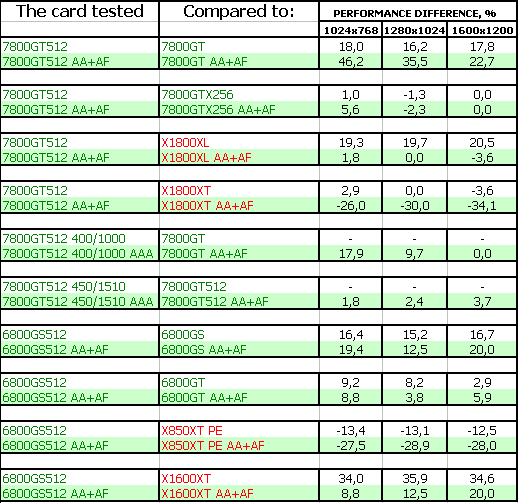
In this game, heavy for accelerators, the 7800 GT from Gainward gets a nice advantage over the reference card. Even if it cannot outperform the 7800 GTX, at least they are on a par now. That's a huge plus. We can see the same advantage over the X1800 XL as well. Only the X1800 XT is a leader again. But don't forget that its price is much higher. 512 MB of memory produce a proper effect, but only at 1024x768, where the card provides excellent gameplay. Considering how voracious this game towards a GPU, we expected that increasing the memory bandwidth would yield little effect and we were right. The situation with 6800 GS is almost the same as in the previous case. Only the advantage over the 6800 GT is not that large and the 6800U is still a leader. However, these cards as well as the X850 XT PE are much more expensive. The X1600 XT is an outsider. Yep, this card is cheaper. Though it's not so cheap but it can lose 30% and more. Splinter Cell Chaos Theory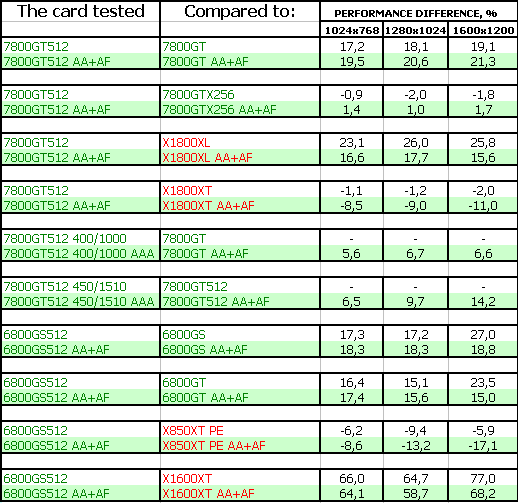
The situation is almost the same. We can again see that the 7800 GT GLH does not catch up only with the more expensive X1800 XT. What concerns the effect of memory capacity and bandwidth, we can see that this game is critical to memory bandwidth, so increasing it produces a good effect. 512 MB of memory play a much less important role. What concerns the 6800 GS GLH, everything is the same. Nothing new. The advantage over the X1600 XT is very large, evidently out of proportion to the price difference. Call Of Duty 2 DEMO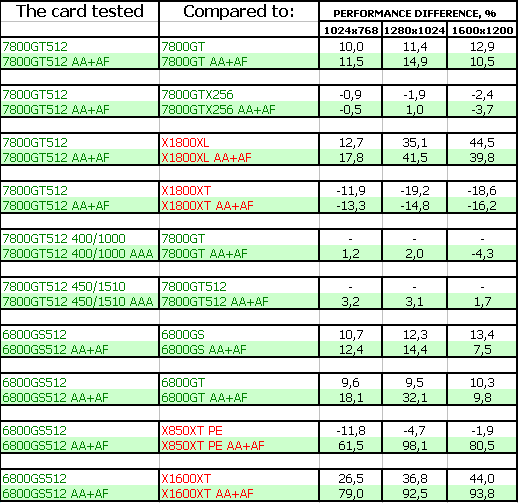
Half-Life2: ixbt01 demoTest results: Half-Life2, ixbt01 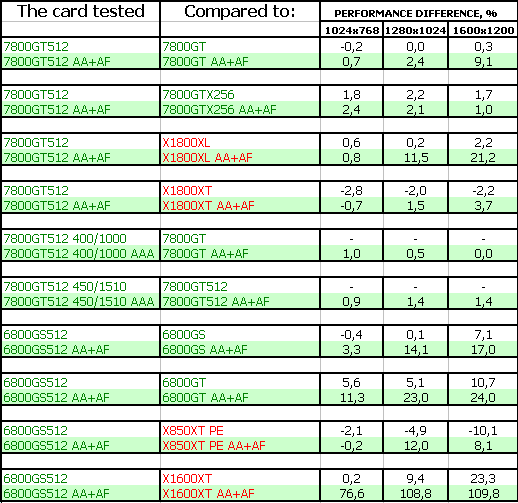
Considering that this game cannot load top accelerators to the brim even in regular AA+AF mode (AA4x and AF 16x) and is limited by a CPU, all performance gains smoothed out a little, but the same tendency is noticeable. And the situation with the 6800 GS GLH is more prominent: even the X850 XT PE is outperformed in 1600x1200 (where the gameplay is rather decent even for such a card). To say nothing of the X1600 XT.
Game tests that heavily load pixel pipelines with texturing, active operations of the stencil buffer and shader unitsDOOM III High mode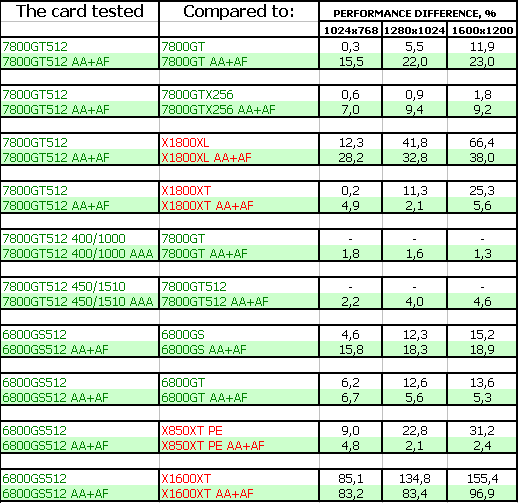
Chronicles of Riddick, demo 44
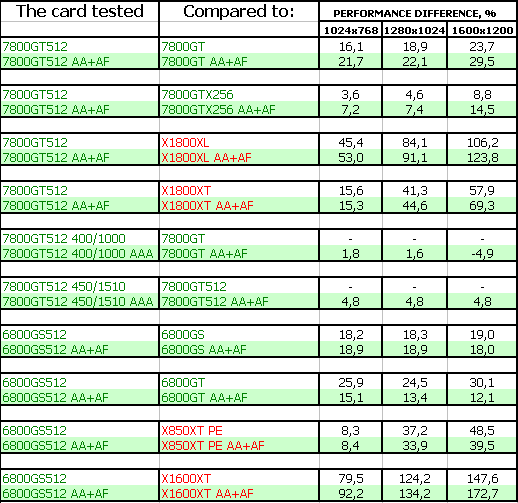
The situation with competing cards from ATI is clear - they are utterly defeated and even the X1800 XT is an outsider in comparison with the 7800 GT GLH. Both new cards from Gainward demonstrate excellent results!
Synthetic tests that heavily load shader units3DMark05: MARKS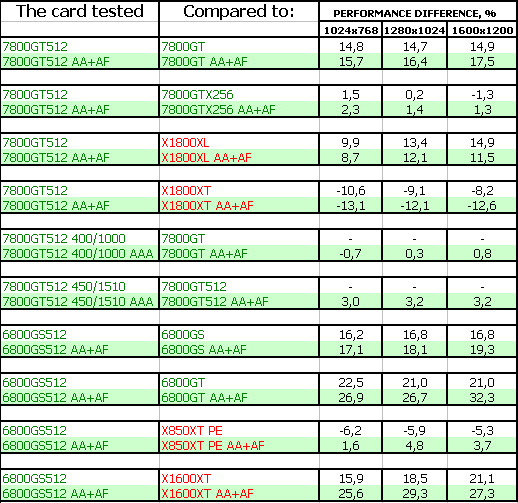
As soon as only shaders and shaders alone snap into action, the 7800 GT GLH easily outperforms the reference card. It catches up with the GTX 256, outperforms the X1800 XL, and is outperformed by 12% by the X1800 XT. Everything is fair and logical. Considering requirements of this test to the core, all memory tests revealed only measly influence of 512 MB as well as the increased memory bandwidth. The 6800 GS GLH demonstrates a similar situation, even the X1600 XT with its 12 pipelines and 600 MHz at the core cannot beat the new product from Gainward. The 256-bit bus as well as 12 texture units and 12 ROPs do their part. 3DMark06: MARKS Shader Model 2.0
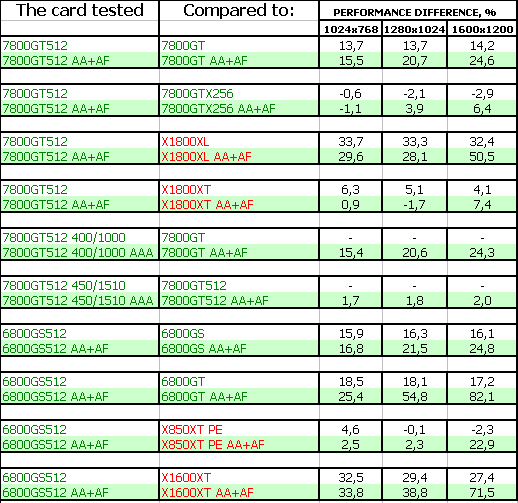
It's almost a similar situation. But! This test is very critical to the memory capacity of a video card! We can see that 512 MB on board of the 7800 GT produce a great effect! The gain reaches 24%! Memory bandwidth is of little importance here. The 6800 GS demonstrates stunning results and brilliant victories! 3DMark06: MARKS Shader Model 3.0
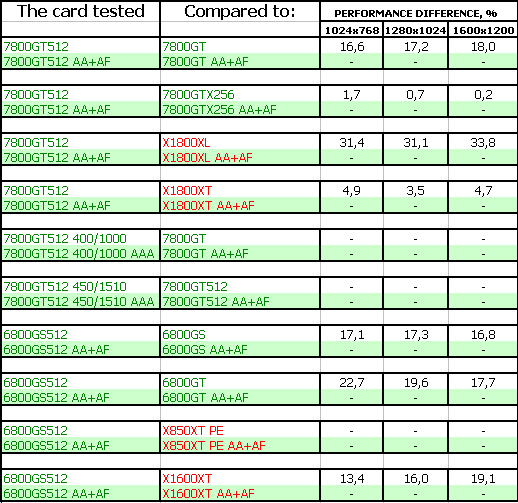
Alas, in this case we compare the cards only without AA+AF, as all GeForces fail the tests because of the HDR and AA incompatibility. The 7800 GT fairs very well, it's victorious. But inoperable HDR+AA is a fly in the ointment. That's not the fault of the card though, the blame lies with NVIDIA. What concerns the 6800 GS - the situation is the same. ConclusionsGainward Bliss 7800GT/6800GS Goes Like Hell 512MB PCI-E cards are excellent products! Gainward specialists did a great job! Excellent performance, even more expensive competitors are outperformed, an interesting design, moderate prices, they are expected to be only a tad higher than for the regular reference cards. These accelerators produce the best impression! The company still pays much attention to the quality. Both cards have excellent 2D image quality even at 1600x1200@100Hz. I repeat that you can control the cooler noise and so it's not much of a problem. In my opinion, both accelerators will be very popular among gamers. And of course, we cannot do without our traditional phrase: it will all depend on prices.
You can find more detailed comparisons of various video cards in our 3Digest.
Both cards get the Original Design award: 
Gainward Bliss 7800GT/6800GS Goes Like Hell 512MB PCI-E (February 2006).
Theoretical materials and reviews of video cards, which concern functional properties of the GPU ATI RADEON X1800 (R520)/X1600 (RV530)/X1300 (RV515) and NVIDIA GeForce 6800 (NV40/45)/7800 (G70)/6600 (NV43)Write a comment below. No registration needed!
|
Platform · Video · Multimedia · Mobile · Other || About us & Privacy policy · Twitter · Facebook Copyright © Byrds Research & Publishing, Ltd., 1997–2011. All rights reserved. | ||||||||||||||||||||||||||||||||||||||||||||||||||||||||